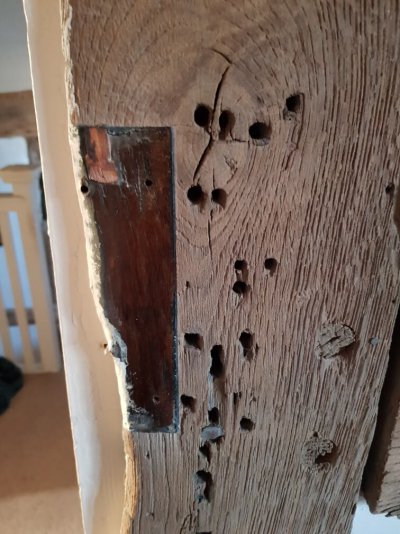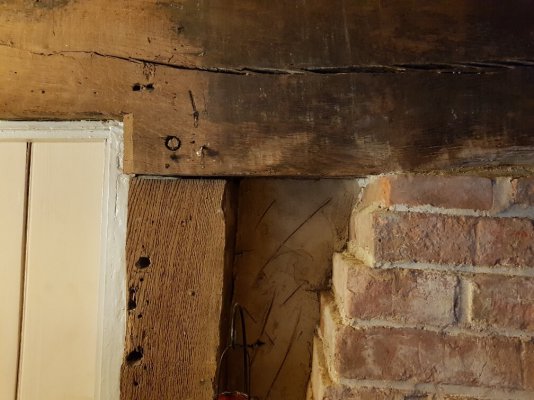In the 70s/80s the owner of our house decided it would be a good idea to paint the internal timber frame of our cottage black.
Then the previous short term owners to us, in their bid to 'modernise' the house, had the internal frame sandblasted. I'm sure they thought they were doing the right thing and didn't appreciate their mistake, but it is done.
We are therefore left with a dull and pale finish to our high quality, well crafted oak that is at least 400 years old and unfortunately all of the areas of wood where there were infestations, are now very pitted, rough and sharp with the softened surface and often original shape, long gone.
We have been living with this for the last 5 years happily, and the tone of the wood is actually quite nice and much darker could become a bit overbearing in a cottage. Recently I have stripped and restored the three oldest of our internal doors, on one of which I removed the unnecessary, more modern knob. I therefore also removed a piece of wood on the original door frame that had been a makeshift location for the strike plate. I thought it hadn't been there that long, but it obviously precedes any black painting as the oak underneath has a lovely warm, smooth and slightly glossy finish. Unfortunately now I have seen this, I am looking at the rest of the frame in disappointment!

Elsewhere, except less well preserved, where I have removed coverings during restoration, you can see the variation in tone and colour of the oak, such as above our fireplace where it was protected from the paint and subsequent sand, by a mantle.

All of this has made me start to think about the possibility of staining and finishing the internal timber... there is a lot of wood - 2 bays, 2 storeys and almost all of the frame exposed. This total area in itself doesn't bother me so much as the terrible finish on many of the surfaces due to the blasting over infestation.
I also wonder how the original/previous finish was achieved, as any stain I would have expected to penetrate deeper into the wood, whereas this really looks like a surface finish.
I suppose I am really looking for thoughts / experiences from anyone who has undertaken the same. I also really don't need any more distractions if I am honest, given I still have our entrance hall brick floor to lay, a false ceiling to remove, a redundant Victorian chimney stack to dismantle and subsequent roof repairs, re-wiring, plumbing and plastering. But I can't help but wonder how much better everything would look, especially having restored some of the old plank doors recently and also four wooden floors which make such a difference....!!!
Then the previous short term owners to us, in their bid to 'modernise' the house, had the internal frame sandblasted. I'm sure they thought they were doing the right thing and didn't appreciate their mistake, but it is done.
We are therefore left with a dull and pale finish to our high quality, well crafted oak that is at least 400 years old and unfortunately all of the areas of wood where there were infestations, are now very pitted, rough and sharp with the softened surface and often original shape, long gone.
We have been living with this for the last 5 years happily, and the tone of the wood is actually quite nice and much darker could become a bit overbearing in a cottage. Recently I have stripped and restored the three oldest of our internal doors, on one of which I removed the unnecessary, more modern knob. I therefore also removed a piece of wood on the original door frame that had been a makeshift location for the strike plate. I thought it hadn't been there that long, but it obviously precedes any black painting as the oak underneath has a lovely warm, smooth and slightly glossy finish. Unfortunately now I have seen this, I am looking at the rest of the frame in disappointment!

Elsewhere, except less well preserved, where I have removed coverings during restoration, you can see the variation in tone and colour of the oak, such as above our fireplace where it was protected from the paint and subsequent sand, by a mantle.

All of this has made me start to think about the possibility of staining and finishing the internal timber... there is a lot of wood - 2 bays, 2 storeys and almost all of the frame exposed. This total area in itself doesn't bother me so much as the terrible finish on many of the surfaces due to the blasting over infestation.
I also wonder how the original/previous finish was achieved, as any stain I would have expected to penetrate deeper into the wood, whereas this really looks like a surface finish.
I suppose I am really looking for thoughts / experiences from anyone who has undertaken the same. I also really don't need any more distractions if I am honest, given I still have our entrance hall brick floor to lay, a false ceiling to remove, a redundant Victorian chimney stack to dismantle and subsequent roof repairs, re-wiring, plumbing and plastering. But I can't help but wonder how much better everything would look, especially having restored some of the old plank doors recently and also four wooden floors which make such a difference....!!!

